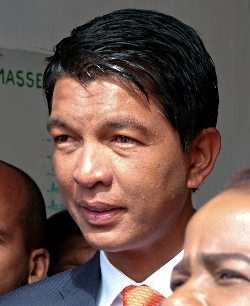 The Republic of Madagascar (or "Madagascar" for short) is an Island country in the Indian Ocean about 420 km (or 260 miles) east of the coast of Mozambique in south-eastern Africa. Madagascar is Africa's biggest island country and the fourth largest Island in the world (after Greenland, New Guinea, and Borneo).
The Republic of Madagascar (or "Madagascar" for short) is an Island country in the Indian Ocean about 420 km (or 260 miles) east of the coast of Mozambique in south-eastern Africa. Madagascar is Africa's biggest island country and the fourth largest Island in the world (after Greenland, New Guinea, and Borneo).
The Republic of Madagascar has a total land area of about 592,800 squared kilometers with an estimated population of 30 million people. Madagascar's population growth rate hovers around 2.6%.
Madagascar is divided into six provinces called faritany. Antananarivo (the capital of Madagascar), Antsiranana (in the north), Fianarantsoa, Mahajanga (mostly an uninhabited area on the west coast), Toamasina, and Toliara. The capital of Madagascar, Antananarivo (meaning 'The City of Thousands' in Malagasy), has a metro area population of about 3.8 million people.
The Republic of Madagascar (previously known as the "Malagasy Republic") is a culturally rich island country containing several different ethnic and racial groups. Cotiers, Creole, Comoran, Malayo-Indonesian, French, Indian, etc. are some of the major ethnic and racial groups living in Madagascar today. The Island of Madagascar was first inhabitted by continental Africans who travelled in boats about 2000 years ago.
Madagascar gained its independence from France and became a republic on June 26, 1960. French and Malagasy are the two official languages used in Madagascar today. The Republic of Madagascar is mostly Christian. Some estimates put the percentage of Christians in Madagascar at 60-85%.
In terms of plants and animal species, there is no place like Madagascar. Madagascar is a little paradise on its own. Madagascar has the most beautiful blend of plants and animal species, some found nowhere else in the world. For example, there are about 10,000 plant species native to Madagascar, 90% of which is found nowhere else in the world.
Besides the rich plants and animal species, The Republic of Madagascar is also blessed with abundance of natural resources such as graphite, chromite, coal, bauxite, salt, quartz, tar sands, mica, fish, hydropower, rare earth elements, semiprecious stones, etc.
However, despite the abundance of natural and human resources, the Republic of Madagascar, just like most other African countries today, faces so many political, developmental and social challenges.
Madagascar has a literacy rate of 68% for the total population with the female literacy rate hovering around 62.5%. In other words, just about 62.5% of Madagascar's total female population above the age 15, can read and write.
Despite the abundance of natural and human resources, over 75% of Madagascar's population lives on less than $1.90 a day. According to a recent World Bank report, about 78.8% of Madagascar's population lived below the international poverty line of $1.90 a day in 2012. Not much has changed.
In fact, according to a recent UNICEF multi-dimensional poverty report, about 67.6% of Madagascar's children are multi-dimensionally poor. In other words, about 2 out of every 3 children in Madagascar suffer material deprivation in at least two different dimensions of well-being. According to UNICEF's analysis, the extreme poverty rate in the rural areas of Madagascar is more than twice as high as in urban the areas. Also, the south-western parts of Madagascar are the most seriously affected. According to UNICEF, almost one in every two children lives in extreme poverty in Madagascar's regions of Atsimo Andrefana (49.3%) and Ihorombe (49.1%).
Madagascar is mostly tropical and the majority of the Malagasy population is into agriculture. Some grow cash crops such as coffee, cocoa, sugar cane, and regular crops like Cassava or tapioca, rice, beans, peanuts, etc. and rear animals such as goats, sheep, chickens, etc. mostly to feed themselves and their families. However, natural hazards such as periodic cyclones, drought, locust infestation, etc. sometimes put many farming communities in despair.
Madagascar has HIV/AIDS adult prevalence rate of about 0.2%. Although this is far better than in most other African countries, about 24000 people were living with HIV/AIDS in 2009 with about 1700 deaths recorded in the same year. Besides HIV/AIDS, several other diseases such as chikungunya, malaria, plague, bacterial and protozoal diarrhea, hepatitis A and typhoid fever continue to threaten several lives in Madagascar today.
Just like in most other African countries today, poor governance and corruption continue to tear Madagascar apart.
